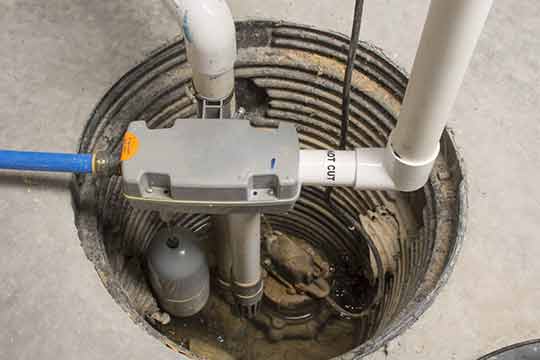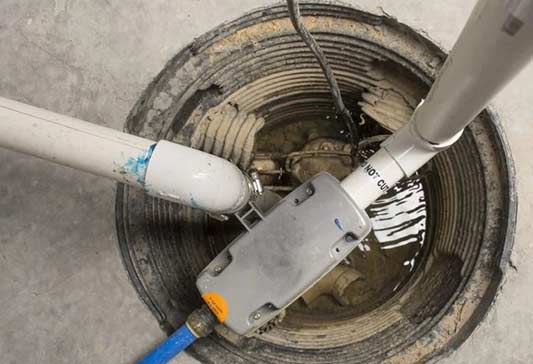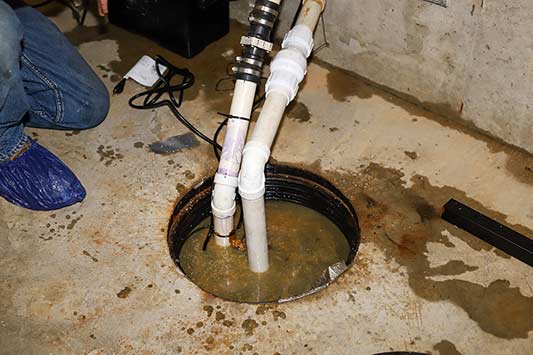
Prevent flooding and water damage by mastering these key troubleshooting steps to maintain your sump pump’s performance. A sump pump is an essential component in many homes, especially those prone to flooding. Ensuring that your sump pump is running efficiently can save you from costly repairs and potential water damage. Below we will discuss eight essential troubleshooting tips to keep your sump pump in top condition.
Maintaining your sump pump not only protects your property but also provides peace of mind. Knowing that your home is safeguarded against potential water damage allows you to focus on other important aspects of homeownership. By taking a proactive approach to sump pump maintenance, you can avoid the stress and expense associated with water-related emergencies.
Additionally, understanding the mechanics and functionality of your sump pump can empower you as a homeowner. When you are familiar with how your sump pump operates, you can more easily identify and address issues before they become major problems. This knowledge also enables you to communicate effectively with professionals if you require their assistance.
Understanding the Importance of a Sump Pump
A sump pump is designed to remove water that has accumulated in a water-collecting sump basin, commonly found in the basements of homes. This device is crucial for preventing basement flooding and water damage, which can lead to mold growth and structural issues. Regular maintenance and troubleshooting are necessary to ensure the sump pump functions correctly when needed.
Basement flooding can occur for various reasons, including heavy rainfall, melting snow, and rising groundwater levels. When water infiltrates your basement, it can cause significant damage to your belongings, walls, floors, and foundation. Additionally, excess moisture creates an ideal environment for mold and mildew growth, which can pose health risks to you and your family. A reliable sump pump helps mitigate these risks by efficiently removing water from your basement.
It is also important to recognize that a sump pump can protect more than just your basement. If your home has a crawl space, the sump pump can prevent water from accumulating there as well. Water in a crawl space can lead to similar issues as basement flooding, including structural damage and mold growth. By keeping both your basement and crawl space dry, a sump pump helps maintain the overall integrity of your home.
Tip 1: Regularly Inspect Your Sump Pump
The first step in maintaining your sump pump is to conduct regular inspections. Check the pump for any visible signs of wear and tear, such as cracks or rust. Ensure that the power cord is in good condition and securely connected. Additionally, inspect the sump basin for debris or obstructions that could impede the pump’s operation.
During your inspections, pay close attention to the condition of the pump’s components. Look for any signs of corrosion, which can weaken the pump’s structure and reduce its effectiveness. If you notice any damaged parts, consider replacing them promptly to prevent further issues. Regular inspections also allow you to identify potential problems early, giving you the opportunity to address them before they escalate into major concerns.
Furthermore, check the alignment and positioning of the sump pump within the basin. The pump should be upright and stable, without any tilting or shifting. An improperly positioned pump can lead to inefficient operation and potential damage. By ensuring that the pump is correctly placed, you can optimize its performance and longevity.
Tip 2: Test the Pump Periodically
Testing your sump pump periodically is essential to ensure it is functioning correctly. To test the pump, pour a bucket of water into the sump basin. The pump should activate and begin to remove the water. If it does not, there may be an issue with the float switch or the pump itself. Address any problems immediately to prevent potential flooding.
In addition to pouring water into the sump basin, you can also test the pump by lifting the float switch manually. This action simulates the rising water level and should trigger the pump to start. If the pump fails to activate, it may indicate a malfunction that requires further investigation. Regular testing helps you verify that the pump is ready to perform when needed, especially during periods of heavy rainfall or rapid snowmelt.
When testing the pump, observe its operation closely. Listen for any unusual noises, such as grinding or rattling, which may indicate mechanical issues. Also, check the water flow to ensure that it is being discharged efficiently. If you notice any irregularities, take the necessary steps to diagnose and resolve the problem. Regular testing is a proactive measure that helps maintain the reliability of your sump pump.
Tip 3: Clean the Sump Basin and Pump
Over time, dirt, debris, and sediment can accumulate in the sump basin and affect the pump’s performance. Regularly cleaning the sump basin and the pump will help maintain optimal operation. Remove any debris from the basin and clean the pump’s inlet screen to prevent clogs. This simple maintenance task can significantly extend the life of your sump pump.
When cleaning the sump basin, use a wet/dry vacuum to remove any standing water and debris. Be thorough in your cleaning process, as even small particles can obstruct the pump’s inlet and reduce its efficiency. Additionally, inspect the pump’s impeller for any signs of blockage or damage. Keeping the sump basin and pump clean ensures that water can flow freely and be efficiently pumped out of your home.
Consider establishing a regular cleaning schedule to keep the sump basin and pump in optimal condition. Depending on the environment and the amount of debris, you may need to clean the basin more frequently. By adhering to a consistent cleaning routine, you can prevent buildup and ensure the pump operates smoothly. Regular cleaning is a simple yet effective way to maintain the longevity and performance of your sump pump.
Tip 4: Check the Discharge Line
The discharge line is responsible for carrying water away from your home. It is crucial to ensure that the discharge line is clear of obstructions and properly connected. Inspect the line for any signs of damage or blockages, and make sure it is directed away from your home’s foundation. A clogged or damaged discharge line can cause water to back up and flood your basement.
During your inspection, pay attention to the discharge line’s connection points. Ensure that all joints are secure and free from leaks. If the discharge line runs underground, consider using a sewer snake or garden hose to clear any potential blockages. Additionally, verify that the discharge point is located a safe distance from your home’s foundation to prevent water from seeping back into the basement. Proper maintenance of the discharge line is essential for the sump pump’s overall effectiveness.
In colder climates, it is important to protect the discharge line from freezing. Frozen discharge lines can block water flow and cause the sump pump to fail. To prevent freezing, insulate the discharge line or use a freeze-resistant hose. Additionally, ensure that the discharge point is free from snow and ice buildup. Taking these precautions helps maintain the functionality of the discharge line and prevents potential flooding during winter months.
Tip 5: Ensure the Float Switch is Functioning Properly
The float switch is a critical component of the sump pump, as it activates the pump when the water level in the sump basin rises. Ensure that the float switch moves freely and is not obstructed by any debris. If the float switch is not functioning correctly, the pump may not activate when needed, leading to potential flooding.
Float switches come in various designs, including tethered, vertical, and electronic. Regardless of the type, it is important to ensure that the float switch is properly positioned and free from any hindrances. If you notice that the float switch is sticking or not moving smoothly, clean it and remove any debris that may be causing the issue. A well-functioning float switch is essential for the sump pump’s automatic operation, ensuring that it activates promptly when water levels rise.
Regularly test the float switch by manually raising and lowering it to simulate changing water levels. Observe the pump’s response and ensure that it activates and deactivates appropriately. If the float switch shows signs of wear or damage, consider replacing it with a new one. Maintaining the float switch in good working condition is crucial for the reliable operation of your sump pump.

Battery backup systems are designed to provide temporary power to the sump pump, allowing it to continue operating until the main power is restored.
Tip 6: Verify the Power Source
A sump pump relies on a consistent power source to operate effectively. Check that the pump is plugged into a working electrical outlet and that the circuit breaker has not tripped. Consider installing a backup power source, such as a battery backup or a generator, to ensure the pump continues to function during power outages.
Power outages can occur unexpectedly, especially during severe weather conditions. To safeguard your home against flooding during a power outage, invest in a reliable backup power source. Battery backup systems are designed to provide temporary power to the sump pump, allowing it to continue operating until the main power is restored. Alternatively, a standby generator can supply power to the entire house, including the sump pump, for an extended period.
In addition to installing a backup sump pump battery, consider installing a high-water alarm system. These alarms alert you when the water level in the sump basin rises above a certain threshold, indicating that the pump may not be functioning properly. High-water alarms provide an added layer of protection by notifying you of potential issues before they lead to significant flooding. By combining backup power with an alarm system, you can enhance the overall reliability of your sump pump system.
Tip 7: Replace the Pump When Necessary
Sump pumps have a limited lifespan, typically ranging from 5 to 10 years. If your pump is nearing the end of its expected life, consider replacing it with a new, more efficient model. Regular maintenance can extend the life of your pump, but it is essential to recognize when it is time for a replacement to avoid potential failures.
When selecting a new sump pump, consider factors such as the pump’s capacity, horsepower, and type (submersible or pedestal). Choose a model that meets the specific needs of your home and provides reliable performance. Additionally, look for features such as a built-in alarm system, which alerts you to potential issues before they escalate. By replacing your aging sump pump with a newer, more efficient model ensures that your home remains protected against water damage.
Speak with a professional to determine the best sump pump for your home. They can assess your specific requirements and recommend a suitable model based on factors such as the size of your basement, the volume of water to be pumped, and the local climate. Professional guidance helps ensure that you select a sump pump that provides optimal performance and reliability for your home.
Tip 8: Schedule Professional Maintenance
While regular DIY maintenance is crucial, scheduling professional maintenance can provide additional peace of mind. A professional plumber can thoroughly inspect your sump pump, identify any potential issues, and perform necessary repairs or replacements. This proactive approach can help ensure your sump pump remains in optimal condition and ready to protect your home from flooding.
Professional maintenance services often include comprehensive inspections, cleaning, and testing of the sump pump system. Technicians have the expertise and tools to detect issues that may not be apparent during a DIY inspection. By scheduling regular professional maintenance, you can address potential problems before they lead to pump failure or water damage. This investment in professional care helps prolong the life of your sump pump and ensures its reliable operation.
In addition to routine maintenance, professionals can also provide valuable advice on improving your sump pump system. They may recommend upgrades or modifications to enhance the pump’s performance and efficiency. By working with experienced plumbers, you can stay informed about the latest advancements in sump pump technology and ensure that your system remains up-to-date.
Wrapping It Up
Maintaining your sump pump is essential for protecting your home from water damage and flooding. By following these eight essential troubleshooting tips, you can ensure that your sump pump remains in top condition and operates effectively when needed. Regular inspections, testing, cleaning, and professional maintenance are key to extending the life of your sump pump and keeping your home safe and dry.
In addition to the tips outlined in this article, consider educating yourself about the specific make and model of your sump pump. Familiarize yourself with the manufacturer’s recommendations for maintenance and operation. By staying informed and proactive, you can maximize the efficiency and longevity of your sump pump. Remember, a well-maintained sump pump is your first line of defense against basement flooding and water damage.
Ultimately, the effort you invest in maintaining your sump pump pays off in the long run. By ensuring that your sump pump is in optimal condition, you can prevent costly repairs, protect your property, and enjoy peace of mind knowing that your home is safeguarded against water damage. Take the time to implement these troubleshooting tips and make sump pump maintenance a priority in your home care routine.


